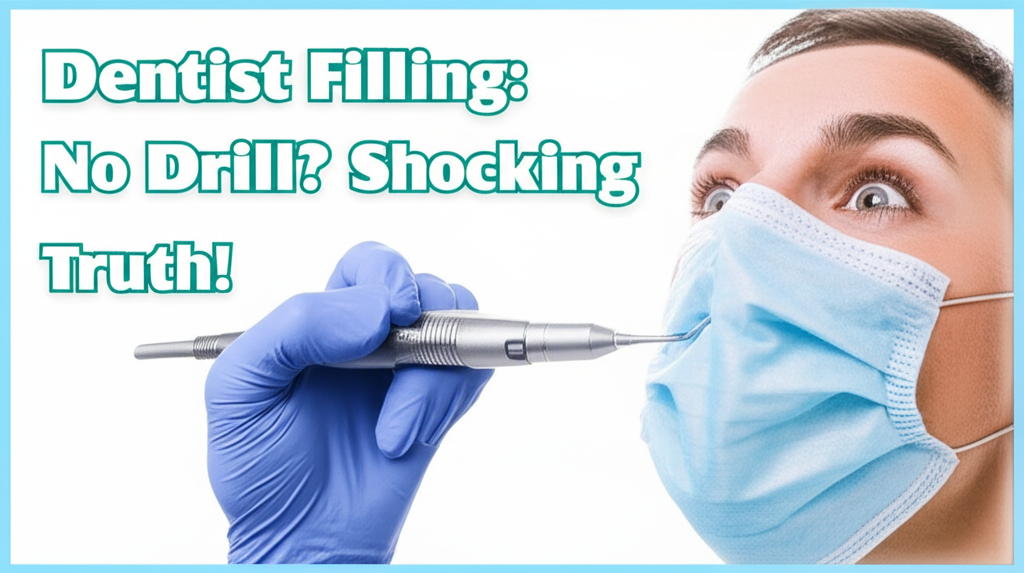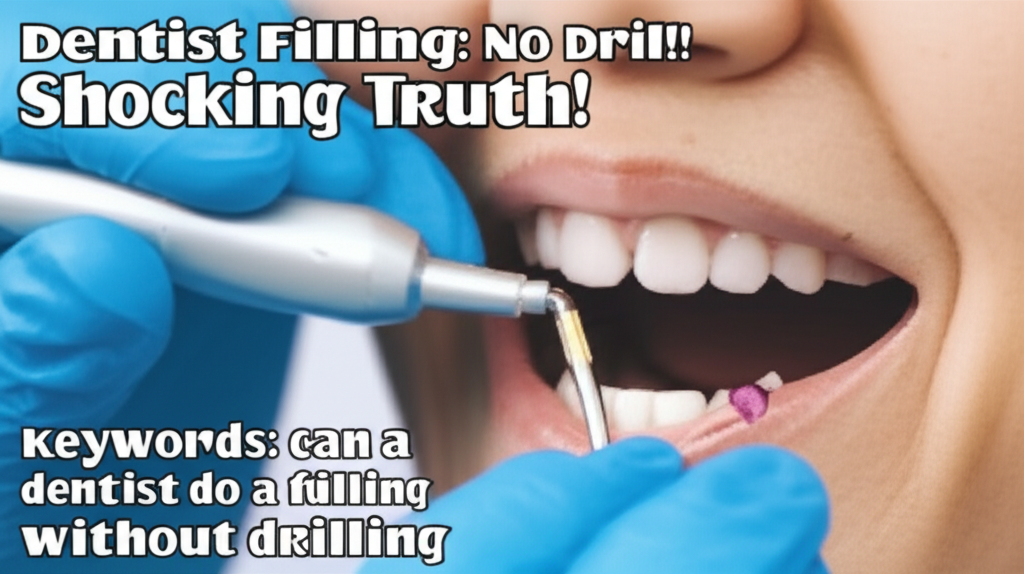Can a dentist do a filling without drilling? Yes, in certain cases, dentists can use alternative methods like air abrasion or laser dentistry for specific types of cavities, potentially reducing or eliminating the need for traditional drilling.
Dentist Filling: No Drill? The Shocking Truth!
Ever find yourself wondering if there’s a way to get a dental filling without the dreaded sound and sensation of a drill? You’re not alone! Many of us associate dental fillings with that high-pitched whirring and the feeling of vibration. It’s a common concern that often leads to anxiety. But what if we told you that in some situations, your dentist might have alternatives to the traditional drill? Stick around, because we’re about to dive into the fascinating world of drill-free dentistry and explore what’s possible when it comes to filling those pesky cavities.
The Evolution of Dental Fillings: Moving Beyond the Drill
For decades, the dental drill has been the go-to tool for removing tooth decay and preparing a tooth for a filling. It’s effective, reliable, and dentists have mastered its use. However, as dental technology advances, so do the methods available. The quest for less invasive and more comfortable dental treatments has led to the development of exciting alternatives that are changing how we approach cavity treatment. These new techniques aim to preserve more of your natural tooth structure and minimize discomfort, making your dental visits a more pleasant experience.
This shift is not about replacing the drill entirely, but rather expanding the toolkit available to dentists. Think of it like a skilled mechanic having a variety of specialized tools for different jobs. Sometimes a good old wrench is perfect, but for intricate work, a precision driver might be better. In dentistry, the drill is still a workhorse, but sometimes, other instruments can achieve the same result with less impact on the tooth.
Can a Dentist Do a Filling Without Drilling? Understanding the Possibilities
The short answer is: yes, in some situations, a dentist can perform a filling without traditional drilling. However, it’s crucial to understand that this isn’t a universal solution for all cavities. The effectiveness of drill-free methods depends heavily on the size and location of the cavity, the type of decay, and the patient’s overall oral health. Let’s explore the primary methods that allow for drill-free or reduced-drill fillings.
Air Abrasion: A Gentle Approach to Cavity Removal
One of the most common and effective alternatives to the dental drill is air abrasion. This technique uses a fine stream of abrasive particles (often aluminum oxide) propelled by compressed air directly onto the tooth decay. It’s a much gentler process compared to drilling, often making a soft “hissing” sound rather than a loud whir.
How Air Abrasion Works:
- A special handpiece delivers a controlled spray of abrasive particles mixed with air.
- These particles precisely remove the decayed tooth material while leaving healthy enamel largely untouched.
- The removed particles and decay are suctioned away simultaneously.
- Once the decay is removed, the tooth is prepared for the filling material, often using minimal or no anesthetic, as the process is typically painless.
Benefits of Air Abrasion:
- Less Discomfort: Often requires little to no local anesthetic.
- Preserves Tooth Structure: Removes only the decayed material, saving more healthy tooth.
- Faster Procedure: Can sometimes be quicker than traditional drilling for small to moderate cavities.
- Reduced Vibration: No high-speed drilling means less vibration for the patient.
- Less Noise: Significantly quieter than a dental drill.
Limitations of Air Abrasion:
- Not for Deep Cavities: Less effective for very large or deep decay that has reached the pulp of the tooth.
- Requires Specific Cavities: Best suited for enamel-based cavities or those in accessible locations.
- Cost: May sometimes be more expensive than traditional drilling, depending on the dental practice and insurance coverage.
- Specialized Equipment: Requires specific air abrasion units, which not all dental offices may have.
Laser Dentistry: Precision and Comfort
Laser dentistry is another innovative approach that can be used for cavity preparation and even some filling procedures. Lasers use concentrated light energy to remove decay, often with remarkable precision and minimal discomfort. This technology has been around for a while but is becoming more accessible and refined.
How Laser Dentistry Works:
- A dental laser emits specific wavelengths of light that can vaporize decayed tooth structure.
- The laser can precisely target and remove only the diseased tissue.
- The heat generated by the laser can also sterilize the area, potentially reducing the risk of future infections.
- After decay removal, the tooth is ready for the filling material. In some cases, lasers can even prepare the tooth surface for better bonding of the filling.
Benefits of Laser Dentistry:
- Pain Reduction: Often eliminates the need for anesthesia.
- Minimally Invasive: Preserves healthy tooth structure.
- Sterilization: The laser can help reduce bacteria in the treatment area.
- Less Vibration and Noise: Offers a quieter, more comfortable experience.
- Precise Control: Allows dentists to remove decay with high accuracy.
Limitations of Laser Dentistry:
- Cavity Size and Depth: While versatile, lasers may not be suitable for very extensive decay.
- Cost: Laser treatments can sometimes be more expensive.
- Availability: Not all dental practices are equipped with the latest laser technology.
- Material Compatibility: Certain filling materials might interact differently with laser treatments.
Remineralization and Early Intervention: Preventing the Need for Fillings
Beyond these advanced techniques, the best way to avoid drilling altogether is to prevent cavities from forming or to catch them in their earliest stages. Dentists are increasingly focusing on preventive care and minimally invasive techniques for incipient (early) cavities.
What is Remineralization?
Tooth enamel is constantly undergoing a process of demineralization (losing minerals) and remineralization (gaining minerals). When bacteria in the mouth produce acids, they can start to demineralize enamel, leading to a white spot lesion – the very first sign of a cavity. If caught early, this process can be reversed.
How Remineralization Works:
- Fluoride Treatments: Professional fluoride applications, or using fluoride toothpaste and mouthwash at home, help strengthen enamel and promote remineralization.
- Dietary Changes: Reducing sugar and acid intake starves the bacteria that cause decay.
- Regular Dental Cleanings: Professional cleanings remove plaque and tartar, reducing the bacterial load.
- Sealants: Dental sealants are thin, protective coatings applied to the chewing surfaces of back teeth, preventing decay in the grooves and pits.
For very small, early-stage cavities (often called white spot lesions), a dentist might recommend a remineralization therapy instead of a filling. This could involve applying high-concentration fluoride or using special dental products that help rebuild the enamel. This approach completely avoids drilling!
You can learn more about the importance of enamel and dental health from resources like the National Institute of Dental and Craniofacial Research (NIDCR).
When is Drilling Still Necessary?
While the advancements are impressive, it’s important to be realistic. Traditional drilling remains the most effective method for many dental situations. These include:
- Extensive Decay: When a cavity is large or has spread deep into the tooth, drilling might be the only way to remove all the decay and properly prepare the tooth for a strong filling.
- Cavities Near the Gumline: Decay in areas that are difficult to access might still require the precision of a drill.
- Root Canal Treatment: Accessing the inside of the tooth for a root canal almost always requires drilling.
- Restorative Procedures: Preparing a tooth for crowns, bridges, or veneers typically involves drilling to shape the tooth.
- Patient Anatomy: Sometimes, the specific shape or position of a tooth can make alternative methods less feasible.
A dentist will always assess the situation carefully and choose the method that is best suited for your specific needs, aiming for the most conservative and effective treatment.
Comparing Drill-Free Options
To help illustrate the differences, let’s look at a simplified comparison:
| Feature | Traditional Drill | Air Abrasion | Laser Dentistry |
|---|---|---|---|
| Discomfort Level | Moderate to High (often needs anesthesia) | Low (often no anesthesia needed) | Very Low (often no anesthesia needed) |
| Tooth Structure Preservation | Can remove healthy structure | Highly precise, preserves more | Highly precise, preserves more |
| Noise & Vibration | High | Low | Very Low |
| Effectiveness for Large Cavities | High | Limited | Limited |
| Cost/Availability | Widely available, standard cost | Less common, potentially higher cost | Less common, potentially higher cost |
Your Dentist: The Best Resource for Information
It’s essential to have open communication with your dentist. If you’re particularly anxious about dental drills or prefer a more conservative approach, discuss your concerns during your next check-up. Your dentist can explain the various treatment options available to you, based on your specific dental needs. They can also inform you if their practice offers alternative technologies like air abrasion or laser dentistry.
Remember, your dentist’s primary goal is to provide you with the best possible oral health care. They are trained to use a range of techniques and technologies to achieve this. Don’t hesitate to ask questions about the tools they use and why they recommend a particular treatment method. Understanding the process can significantly reduce anxiety and empower you to make informed decisions about your dental health.
For more on dental technologies and patient comfort, you might find information on the American Dental Association’s MouthHealthy.org helpful.
Frequently Asked Questions About Drill-Free Fillings
Can any dentist do a filling without drilling?

Not all dentists may have the specialized equipment or training for advanced drill-free techniques like air abrasion or laser dentistry. While many dentists are adopting these technologies, it’s best to inquire with your specific dental practice about the services they offer.
Are drill-free fillings as effective as traditional fillings?
For appropriate cases (small to moderate cavities), drill-free methods can be just as effective. They remove decay precisely and allow for strong bonding of filling materials. However, for extensive decay, traditional drilling might still be the most reliable method to ensure all decay is removed.
What is the cost difference between drill-free and traditional fillings?
Drill-free options like air abrasion or laser dentistry can sometimes be more expensive due to the specialized equipment and training involved. However, costs vary widely by practice and location. It’s advisable to discuss potential costs with your dentist and check your insurance coverage.
Is a filling without a drill completely painless?
These methods are significantly less invasive and often cause much less discomfort, frequently eliminating the need for local anesthetic. However, individual experiences can vary. Your dentist will always prioritize your comfort during any procedure.
What are the signs that I might be a candidate for a drill-free filling?
If your cavity is detected very early (often appearing as a small white spot or a very small dark spot on an X-ray or visual exam) and is limited to the enamel or just beneath it, you might be a candidate. Your dentist will be able to assess this during your examination.
Can all types of filling materials be used with drill-free techniques?
Generally, yes. Once the decay is removed using air abrasion or laser, the tooth surface is prepared for standard dental filling materials like composite resin, glass ionomer, or even amalgam, depending on the dentist’s recommendation and your preference.
What should I ask my dentist if I want a drill-free filling?
You can ask: “Do you offer alternative methods to traditional drilling for cavity treatment, such as air abrasion or laser dentistry?” Also, “Based on my current cavity, would one of these methods be suitable for me?” Open communication is key!
